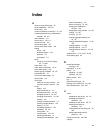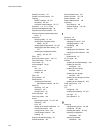Galaxy 65 User Guide
226
SCSI port A SCSI port is an opening at the back of a router that provides connection between the SCSI
adapter and SCSI bus.
Serial Transmission The transfer of data characters one bit at a time, sequentially, using a single
electrical path. See Parallel Transmission.
Simple Network Management Protocol (SNMP) SNMP is the Internet standard protocol, defined in
STD 15, RFC 1157, developed to manage nodes on an Internet Protocol (IP) network.
small computer system interface (SCSI) SCSI is an industry standard for connecting peripheral
devices and their controllers to an initiator. Storage devices are daisy-chained together and connected to
a host adapter. The host adapter provides a shared bus that attached peripherals use to pass data to and
from the host system. Examples of devices attached to the adapter include disk drives, CD-ROM discs,
optical disks, and tape drives. In theory, any SCSI device can be plugged into any SCSI controller.
small form-factor pluggable (SFP)
Type of connector.
speed Speed shows the speed of the FC port interface.
Storage Area Network (SAN) SAN refers to the network behind servers that links one or more servers
to one or more storage systems. Each storage system could be RAID, tape backup, tape library, CD-
ROM library, or JBOD. SANs operate with both SCSI and networking (IP) protocols. Servers and
workstations use the FC network for shared access to the same storage device or system. Legacy SCSI
systems are interfaced using an FC-to-SCSI bridge.
Storage Manager module The controller module which includes an FC-AL 2Gb/s LRC I/O module with
integral Rorke Data Galaxy 65 RAID controller.
target
A target is a device (peripheral) that responds to an operation requested by an initiator (host
system). Although peripherals are generally targets, a peripheral may be required to act temporarily as
an initiator for some commands (for example, SCSI EXTENDED COPY command).
terminator block/termination
A terminator block (or termination) refers to the electrical connection at
each end of a SCSI bus. The terminator block is composed of a set of resistors, or possibly other
components. The function of a terminator block is to provide a pull-up for open collector drivers on the
bus, and also impedance matching to prevent signal reflections at the ends of the cable. SCSI buses
require that a terminator be placed on the 68-pin high-density SCSI connector on the last SCSI
peripheral. Data errors may occur in a SCSI bus that is not terminated.
topology A network topology refers to the physical layout of nodes on a network. Topologies range from
local network topologies to WAN topologies. FC topologies include point-to-point, FC-AL, and fabric.
trap
In the context of SNMP, a trap is an unsolicited message sent by an agent to a management
station. The purpose is to notify the management station of some unusual event.
unkill In Active-Active mode, when a surviving controller removes the reset from the other controller, it
unkills it. The other controller will reboot and attempt to come online.
write-back cache
Memory on the controller that stores data changes until they are written to the disk
drives. In most applications, using the controller’s write-back cache improves performance and ensures
data integrity. Disk drives also have write-back cache, which should be disabled for most applications.


















